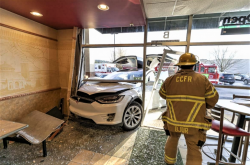
— A Tesla unintended acceleration lawsuit has been dismissed after a Model X driver claimed his vehicle suddenly accelerated on its own and into a Subway restaurant.
The Tesla lawsuit describes unintended acceleration, “in which a Tesla vehicle accelerates to full power even though the driver reports that he or she did not command the acceleration by pressing the accelerator pedal.”
"This defect has allegedly 'manifested in every Tesla model line to date at rates that far exceed historical rates for any other vehicles.'” — Tesla unintended acceleration lawsuit
Plaintiffs Hacene Djemil, Fatiha Djemil and their two children filed the lawsuit against Tesla by alleging the Model X had design defects that caused the crash.
The February 2020 crash involved a 2018 Tesla Model X in Woodland, Washington. Hacene was driving the Tesla through a parking lot when the Model X crashed into the Subway restaurant.
The plaintiffs claim the crash was caused by unintended acceleration and because certain collision mitigation features did not operate correctly or were overridden by unintended acceleration.
Mr. Djemil says he had his foot over the brake pedal as he pulled into a parking space.
According to the Tesla lawsuit:
"Model X vehicle experienced sudden uncommanded full power acceleration, causing it to surge forward across the sidewalk in front of the commercial businesses and toward the glass windows in the front of the Subway restaurant."
The plaintiffs assert Model X defects caused the unintended acceleration, and the vehicle also suffered from failures of the "collision mitigation features."
Tesla Unintended Acceleration Lawsuit Dismissed
In a motion to dismiss, Tesla argues the plaintiffs failed to provide credible evidence to support their claims, or what the lawsuit calls the sudden uncommanded acceleration theory and the collision mitigation features theory.
The Model X driver contends he pressed the brake pedal, not the accelerator pedal.
But Tesla points to testimony from an expert for the plaintiffs who analyzed data from the Model X's event data recorder (EDR) and who authored an expert report regarding the circumstances of the crash.
The expert hired by the Model X driver said in his review of the Carlog data the cause of the crash, “in my opinion . . . would appear to be a Pedal Misapplication of pressing the accelerator pedal instead of the brake when attempting to fully stop in the parking spot.”
It should be noted Carlog data and event data recorder (EDR) data are different.
The plaintiff's expert also said the crash “was initiated by the fact something or someone applied the throttle to 100 percent.”
The expert testified the Tesla event data recorder also indicates the accelerator pedal was pressed.
Tesla asked the expert, ".... and you're not going to tell the jury that that acceleration that began was caused by a defect, are you?" The expert answered, "[i]t was initiated by the fact something or someone applied the throttle to 100 percent.”
According to Judge David G. Estudillo:
"Mr. Djemil's testimony that he pressed on the brake and not the accelerator is clearly contradicted by the testimony of his own expert and the EDR data. There is no other evidence supporting Mr. Djemil's testimony that he stepped on the brakes and a reasonable juror could not find in his favor."
The judge ruled numerous other courts have agreed the Model X event data recorder data is reliable and admissible evidence.
Judge Estudillo also found in favor of Tesla by ruling the plaintiffs failed to provide evidence to show their injuries "were proximately caused by the alleged failure of the Model X's various collision mitigation features."
"Plaintiffs' claims against Tesla are DISMISSED with prejudice." — Judge David G. Estudillo
In 2020, the National Highway Traffic Safety Administration received a petition to investigate Telsa due to alleged unintended acceleration events.
The petition to investigate included 232 complaints which had been submitted to NHTSA, with 203 of those complaints alleging Tesla unintended acceleration caused 203 crashes.
Federal safety regulators spent a year looking into the alleged problem and determined the incidents were caused by "pedal misapplication," where a driver hit the accelerator pedal instead of the brake pedal.
The Tesla unintended acceleration lawsuit was filed in the U.S. District Court for the Western District of Washington: Djemil, v. Tesla, Inc., et al.
The plaintiffs are represented by the Slavik Law Firm, LLC, McCune Wright Arevalo LLP, and Bailey Glasser LLP.




